Gerrymandering the Marsh started as a nature-based fiberart sculpture of a bird crouching on a log on the edge of a wetland. The single bird turned into a tableau explaining how legislative actors draw electoral districts to distort political power.
This is the largest art work I have ever created. It consists of six mixed media fiberart sculptures of Green Herons, nine clay salamanders, knitted vegetation, and nine digitally printed cardboard pedestals. Arranged together it fills roughly 9 x 12 feet of floor space.
It started with a single bird sculpture
On a visit to South Florida, I went to the Wakodahatchee Wetlands with my binoculars to look for birds. I hardly needed the binoculars, because the boardwalk through the former wastewater utility property takes you across ponds, up close to shrubby islands, and under trees where you can see dozens of bird species. For an amateur birdwatcher like me, it was a spectacular.
There were many amazing birds. I was particularly intrigued by the Green Heron. Rusty brown on the neck with a hard-to-describe green/grey/blue coloring on its back. It is smaller than the Great Blue Heron that I am familiar with. Later I learned there are Green Herons back home in Vermont, and I have since spotted them along many waterways. Here’s a picture I took of my new find:
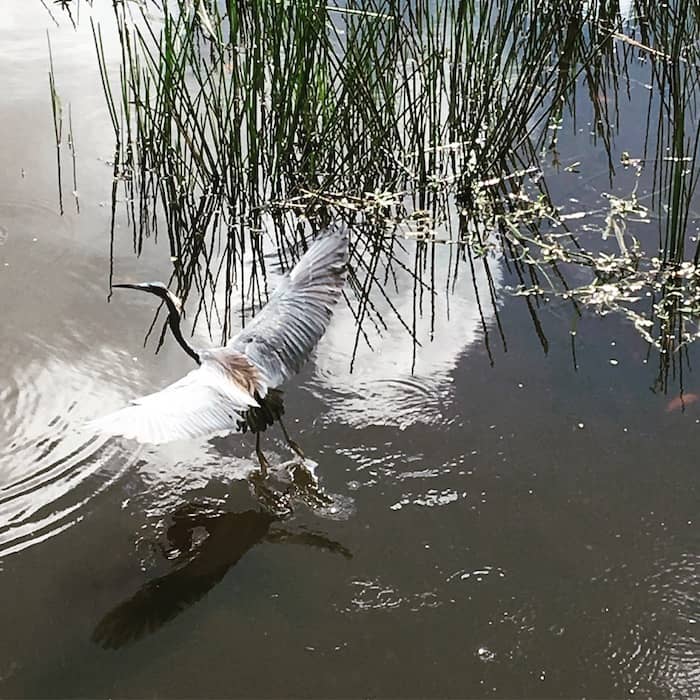
Back in my studio, I made my first Green Heron sculpture. I completed this bird very early in the pandemic and called it Ready because of its posture. I imagine it is looking in the reeds for its food. The crocheted rubber strips of the muddy water were a good repository for the feelings of anger and loss at being confined to my home and neighborhood. To twist the tubing into the bubbly surface, I had to pull the resistant pieces, shaping them to my idea.
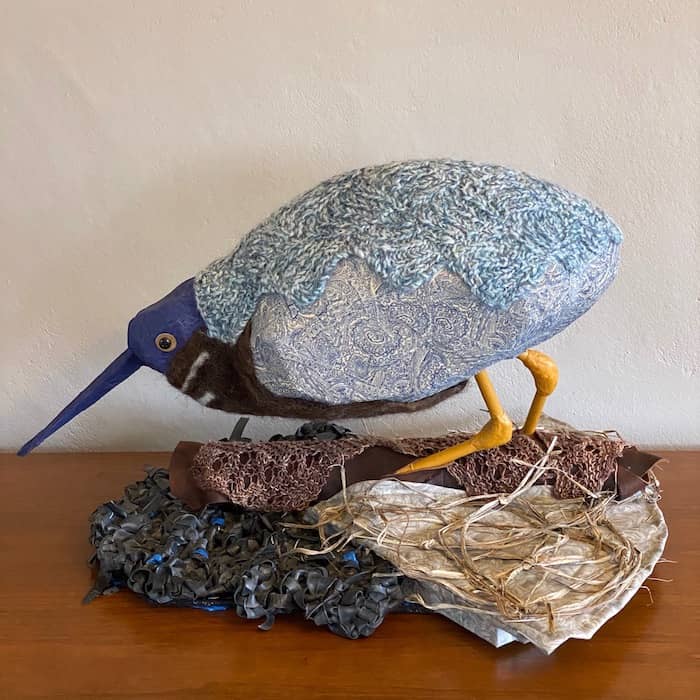
Ready, wool yarns, wool felt, leather, cotton fabric, day lily leaves, rubber, plastic bags, mulberry paper, wood, rigid foam, stone clay, acrylic paint, 14 x 20 x 18 inches © 2020 Eve Jacobs-Carnahan
To evoke the marsh, I added day lily leaves harvested from my flower garden. It was spring and I was cleaning out dead leaves to make room for new growth. Often used for basket making, these leaves are stable and long-lasting.
A month later, I completed a second bird, dubbed Calm. I am not sure whether it was a reflection of a sense of resignation to the pandemic and an aspirational attempt to calm my mind. Either way, the smooth grey linen felt soothing, both to the touch and the eye. Its slight sheen, accentuated by the mesh of the metal screening, suggests light reflecting on water.
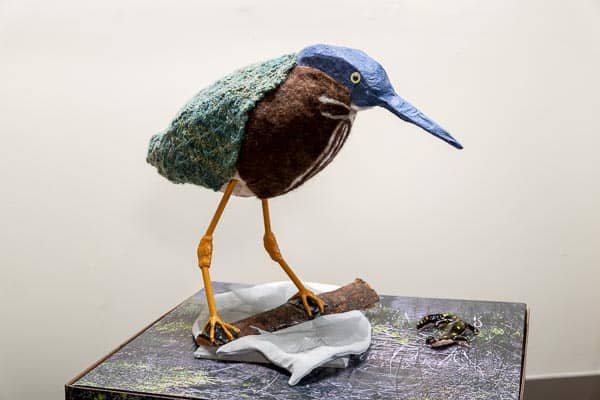
Calm, wool yarns, wool felt, linen, cotton, wire mesh, mulberry paper, wood, rigid foam, stone clay, acrylic paint, 19 x 19 x 14 inches, photo by Paul Rogers, Stowe VT © 2020 Eve Jacobs-Carnahan
Despite their name, Green Herons have feathers that can appear teal, grayish blue, or purple depending on the age of the bird and the way the light catches them. I spent a lot of time studying my photos and those on the Macaulay Library site maintained by Cornell Lab of Ornithology. Selecting the yarn and stitch pattern for the feathers is one of my favorite parts of knitting sculptures.
The birds grow into an art installation
I put the birds aside for several months while I worked on my Knit Democracy Together project, but I continued to mull over the idea of using them to explain gerrymandering. I had a vague notion about arranging them and another creature into voting districts. I thought I could show how boundary lines are often manipulated to distort the voting power of one group over another. When I came back to the birds, I realized the Green Heron was perfect for this story, because it eats small amphibians like salamanders.
The term gerrymandering originates in a mash-up of the word salamander and Elbridge Gerry, a nineteenth-century Massachusetts governor. In 1812, the press parodied the newly drawn legislative districts and called them a monster, which they named a “gerrymander” because of their shape. Including salamanders in the sculpture installation would tie right in to the gerrymandering story.
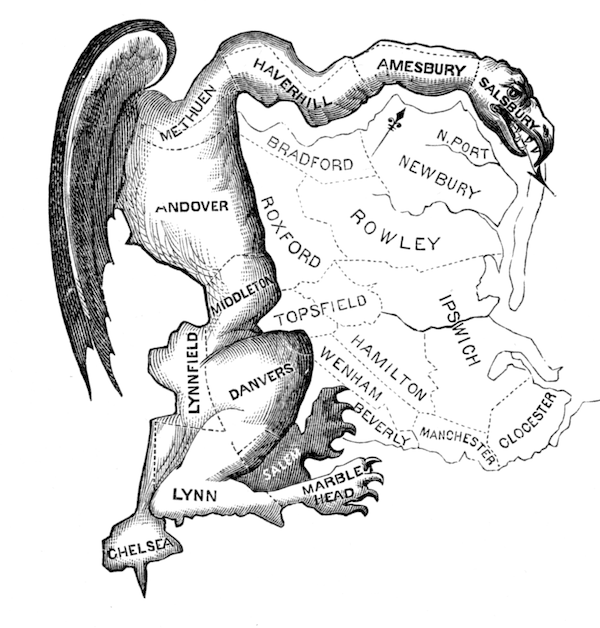
The political cartoon was originally published March 1812 in the Boston Gazette with the caption: “The Gerry-Mander. A new species of Monster which appeared in Essex South District in Jan. 1812.” See history at Massachusetts Historical Society
When state legislatures gerrymander, they draw the boundary lines for legislative districts in ways that distort natural majorities. They crack large urban populations into smaller units and assign them to surrounding communities where they are outnumbered. Or they pack a district full of one type of voter so that those voters have no influence in areas that might naturally be their geographic base. I made a diagram for the installation that would give the herons control of more districts than the salamanders, even though the salamanders greatly outnumber them.
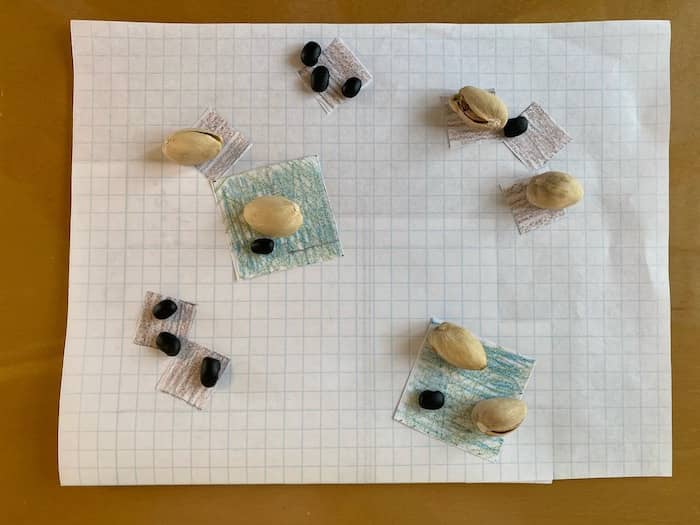
Three-dimensional diagram with nuts and beans arranged in legislative districts, divided to show gerrymandering.
Six related sculptures with variations
With this plan in mind, I set about constructing more Green Herons. I would need six birds and nine salamanders divided into five districts of three creatures each. This was going to be a stretch to build all these pieces for an installation, but the challenge would help me grow as an artist.
Making a series of sculptures that are similar to each other lets me learn from each bird and adjust as I make the next one. I decided to replicate the two initial body shapes of the birds, making another in a crouched position and another standing. I kept the structure and materials of the heads, beaks, legs, and breast consistent in all the birds. This allowed me to focus on the colors and textures for the knitted feathery backs, as well as fabric scraps I would use for the sides of their bodies. I have shared thoughts about knitting feathers before.
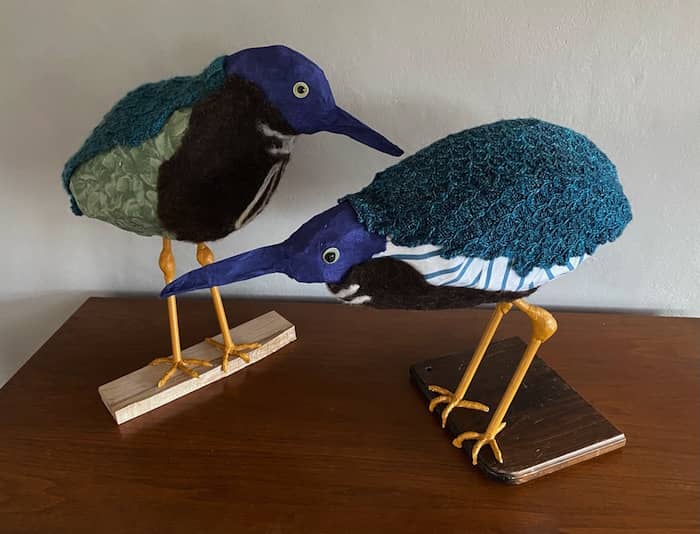
Herons 3 and 4: Alert and Waiting, wool yarns, wool felt, cotton fabric, mulberry paper, wood, rigid foam, stone clay, acrylic paint, each roughly 18 x 20 x 11 inches, © 2021 Eve Jacobs-Carnahan
Consistency is great, but after four birds, I decided I needed more variety in bird postures. So, I made the fifth bird with its head down, foraging for food. Can you see what it captured in its beak?
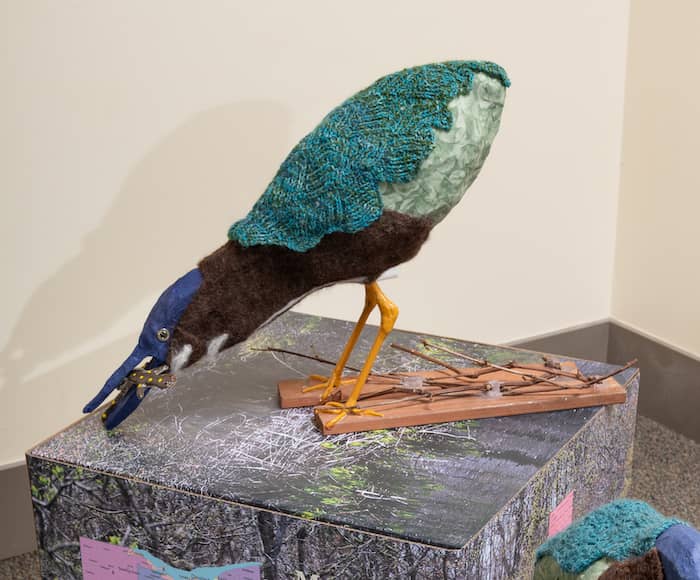
Forager, wool yarns, wool felt, cotton fabric, mulberry paper, wood, rigid foam, stone clay, grapevines, wire, acrylic paint, 18 x 29 x 13 inches, photo by Paul Rogers, Stowe, VT © 2021 Eve Jacobs-Carnahan
Then came a challenge: make one of the birds fly. Or at least come as close to flying as possible without suspending it from the ceiling. I made the sixth bird with wings outstretched, just about to take off from its perch. I have developed a good technique for attaching wire appendages to my sculptures, so making a frame for the wings was fairly straightforward. I wanted the wings to be made of textured lace knitting, so that they would look elegant from both the top and the bottom. I was really excited when my experiment of coating the knitted lace with fabric stiffening polymer succeeded!

Lifting Off, linen yarn, wool felt, cotton fabric, mulberry paper, wood, rigid foam, stone clay, rocks, wire, fabric stiffener, acrylic paint, 15 x 23 x 27 inches, photo by Paul Rogers, Stowe, VT © 2021 Eve Jacobs-Carnahan
Discovering stone clay
Making this art installation expanded my tool box of techniques and materials. After much consideration, I decided the salamanders just wouldn’t look wet and slimy if I made them from yarn. So, I turned to clay. I was already using air dry clay to join wood dowels for the legs, so I had some on hand. Air dry stone clay is strong, easy to shape, and readily accepts paint. Here is a picture of bird legs before they were painted.
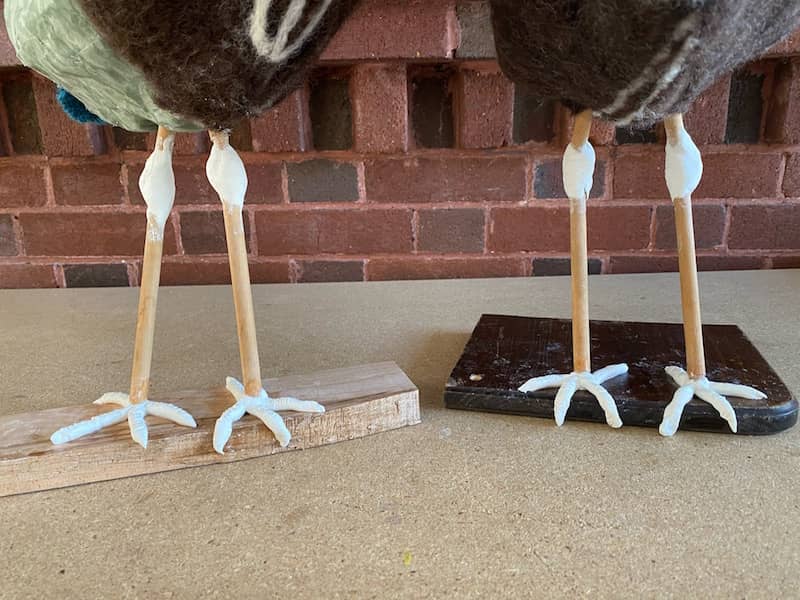
Detail of work in progress showing stone clay joinery and bird feet on wood dowels © 2021 Eve Jacobs-Carnahan
After watching a few YouTube videos, I was ready to work with the stone clay. Learning how to make an armature with wire, aluminum foil, and masking tape was key. I began testing and came up with a good prototype. I tested some paint colors and finished them with a glossy varnish for an appropriately wet and slippery effect. I wrote about this exploration in a previous blog post.
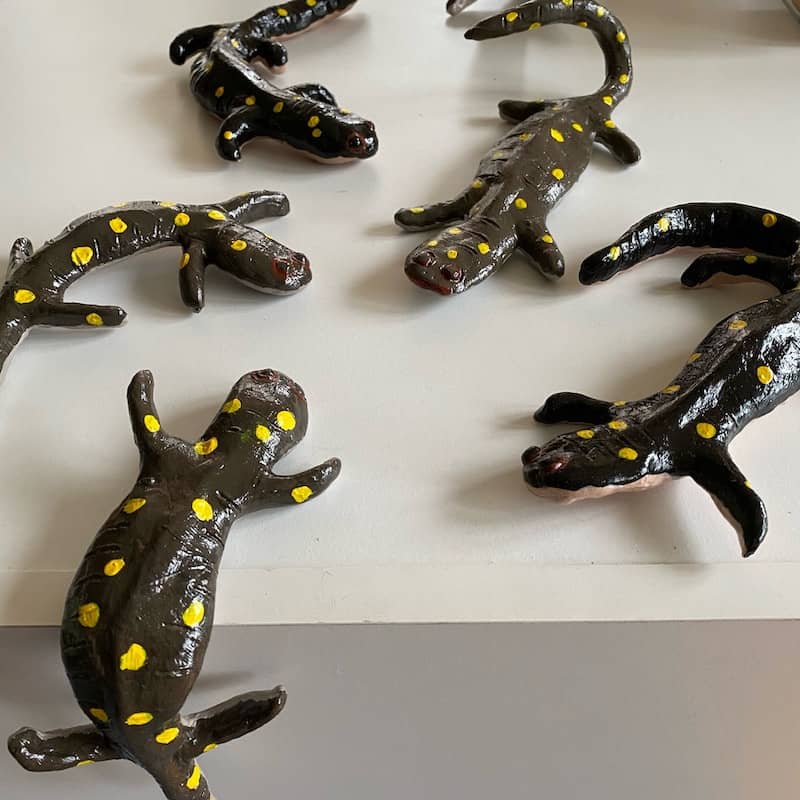
Salamanders for Gerrymandering the Marsh, stone clay over armature of wire, foil, tape, acrylic paint, each roughly 2 x 9 x 6 inches © 2021 Eve Jacobs-Carnahan
Testing the installation with pallets in my living room
Before I even completed the six herons, I needed a plan for incorporating electoral district maps into the scene. My first thought was to paint a floor cloth with boundary lines for the districts and drape it over wood pallets. People reuse shipping pallets for everything, building them into flower boxes, decks, and furniture. I had picked up some wood pallets thinking they could serve as platforms for the birds.
To try out this idea, I moved chairs and tables out of my living room, carried two pallets in from the garage, and spread an old bedsheet on top of them. I set the three completed birds in position.
It looked terrible. Even though the birds are each about 18 inches tall, they looked small in this set-up The pallets raised them up a few inches, but I was still looking down on the birds. The horizontal surface of the fabric dominated the scene. The focus was not on the birds where it should be. I was stumped.
I needed to raise the birds higher off the floor. I considered various types of pedestals: wood, clear plexiglas, thin metal stands. I was stuck wondering where I would put the maps. They were an essential element of the installation. I was afraid the birds would look disconnected from the maps if they stood on pedestals high above a map on the floor.
Pedestals saved my art installation
In my search for pedestals, I discovered a company that could print my digital files on cardboard cubes. Energized by the possibilities, I sketched several layouts and came up with a varied arrangement of cubes for the districts. They ranged from a single large 2 x 2 x 2 foot cube to a group of three small 1 foot cubes. I could create more variations in height by placing the birds atop the cubes or on the floor next to them. I could place the salamanders on the cubes or nestle them in knitted vegetation.
Then I went to work in Photoshop. Not my favorite tool, but more online videos on how to use the selection tools eased the way. I downloaded publicly available maps of gerrymandered legislative districts and superimposed them on photos I had taken of marshy vegetation and wooded river banks. (Read about the inspiration behind my use of maps here.) I used maps of individual districts so that their strangely shaped boundaries could be seen clearly. I also included full state maps showing how the whole state is divided up. To convey the idea that the herons and salamanders live in these districts, I labeled each group of pedestals with a district number.
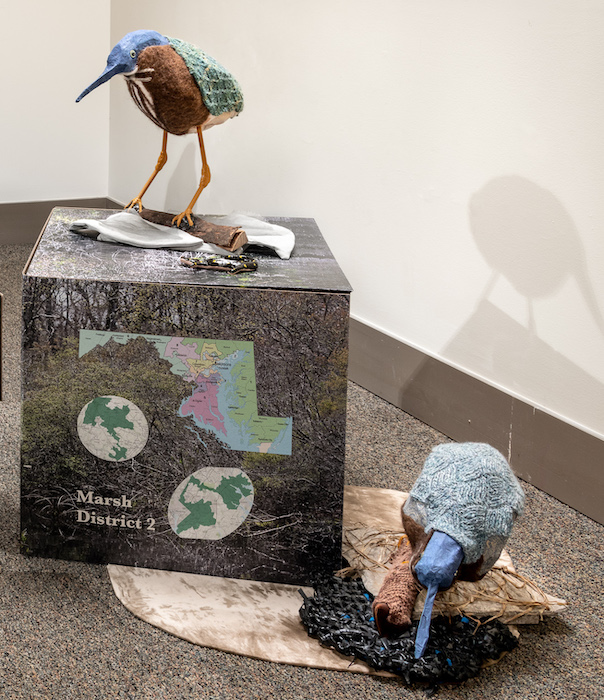
Gerrymandering the Marsh, detail, wool yarns, wool felt, leather, cotton and linen fabrics, day lily leaves, rubber, plastic bags, wire, wire mesh, mulberry paper, wood, rigid foam, stone clay, acrylic paint, digitally printed 2 x 2 x 2 foot cube, photo by Paul Rogers, Stowe, VT © 2021 Eve Jacobs-Carnahan
I ordered two printed cubes to test my design. When they arrived, I was thrilled by how they looked in relation to the birds. The birds were connected to the maps but were not overwhelmed by them. I refined the designs for the rest of the cubes and waited for them to be delivered.
Finally setting up all the elements
Lacking space in my home and studio, I did not get to see the installation as a whole until the photo shoot. The arrangement I chose for the nine cubes takes up roughly 9 x 12 feet of floor space. I laughed when the photographer asked whether the set-up was the way I usually have it. There was no usual yet.
The spacing allows your eye to pause and absorb each set of cubes and each bird. In person, one can walk around the cubes and see them from different angles.
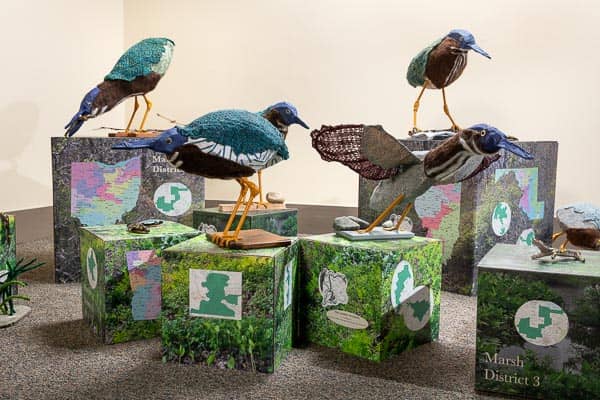
Gerrymandering the Marsh, detail, 43 x 144 x 108 inches, photo by Paul Rogers, Stowe VT © 2021 Eve Jacobs-Carnahan
On each face, there is another legislative map drawn to distort voting power. In the world of this marsh, the salamanders outnumber the herons 3:2. Yet, the way the district lines have been drawn, the six herons control the majority of five of the legislative districts. Packing most of the nine salamanders together deprives them of their natural majority, gerrymandering the marsh.
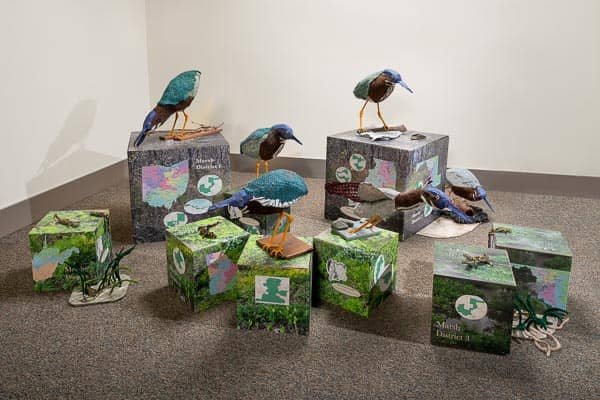
Gerrymandering the Marsh, 43 x 144 x 108 inches, photo by Paul Rogers, Stowe VT © 2021 Eve Jacobs-Carnahan
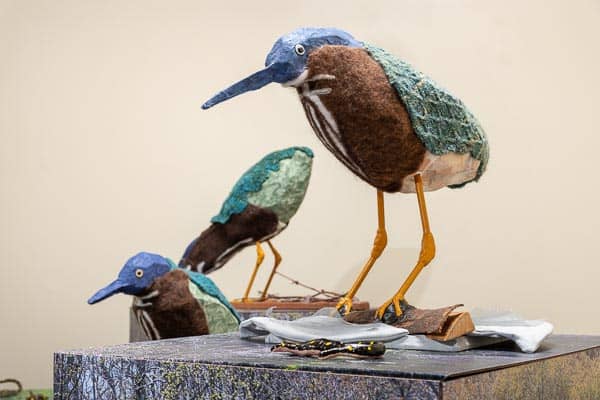
Eve—these are wonderful! Just wonderful. Made my day getting to enjoy them.
Thanks
I’m so glad! I know you took a liking to the first one right at the start.
wow, Eve, this is fabulous. I love all the textures and colors, the postures of the birds and amphibians, the general approachability of the entire installaton. And as ever, I especially love your thoughtful backstory coupled with your constant search for equity in the election process.
Thanks Lynn! I learned that the posture has a lot to do with the legs!
Eve, this is brilliant! I marvel at the way your art and political beliefs blend together. Keep up the fight – it is a long way from over.
Thanks Bev, we all have a lot of work to do!